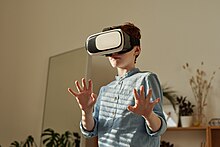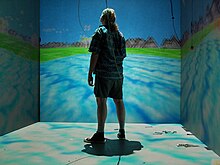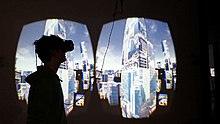Immersion (virtual reality)
The perception is created by surrounding the user of the VR system in images, sound or other stimuli that provide an engrossing total environment.The term is used to describe partial or complete suspension of disbelief, enabling action or reaction to stimulations encountered in a virtual or artistic environment.In addition to these, they add a new category: spatial immersion, which occurs when a player feels the simulated world is perceptually convincing.Presence, a term derived from the shortening of the original "telepresence", is a phenomenon enabling people to interact with and feel connected to the world outside their physical bodies via technology.[4] Most designers focus on the technology used to create a high-fidelity virtual environment; however, the human factors involved in achieving a state of presence must be taken into account as well.[5] Virtual reality glasses can produce a visceral feeling of being in a simulated world, a form of spatial immersion called Presence.Once The Oculus came out in 2012, it revolutionized virtual reality and eventually raised 2.4 million dollars and began releasing their pre-production models to developers.[20] The technologies of VR and AR received a boost in attention when Mark Zuckerberg, founder/creator of Facebook, bought Oculus for 2 billion USD in 2014.Software interacts with the hardware technology to render the virtual environment and process the user input to provide dynamic, real-time response.[24] As well universities the video game industry has received a massive boost from immersive technology specifically Augmented reality.Immersive technology is applied in several areas, including retail and e-commerce,[28] the adult industry,[29] art,[30] entertainment and video games and interactive storytelling, military, education,[31][32] and medicine.As the world of immersive technology becomes deeper and more intense this will be a growing concern for consumers and governments alike as to how to regulate this industry.[citation needed] Molecular nanotechnology is likely to provide the degree of precision required and could allow the implant to be built inside the body rather than be inserted by an operation.[37] A very powerful computer would be necessary for processing virtual reality complex enough to be nearly indistinguishable from everyday life and interacting with central nervous system fast enough.Various immersive technologies such as gestural controls, motion tracking, and computer vision respond to the user's actions and movements.[39] Or training versions such as one which simulates taking a ride through human arteries and the heart to witness the buildup of plaque and thus learn about cholesterol and health.[40] In parallel with scientists, artists like Knowbotic Research, Donna Cox, Rebecca Allen, Robbie Cooper, Maurice Benayoun, Char Davies, and Jeffrey Shaw use the potential of immersive virtual reality to create physiologic or symbolic experiences and situations.Researchers see a great potential in virtual reality tests serving as complementary interview methods in psychiatric care.[41] Immersive virtual reality have in studies also been used as an educational tool in which the visualization of psychotic states have been used to get increased understanding of patients with similar symptoms.[42] New treatment methods are available for schizophrenia[43] and other newly developed research areas where immersive virtual reality is expected to achieve melioration is in education of surgical procedures,[44] rehabilitation program from injuries and surgeries[45] and reduction of phantom limb pain.[66] In the field of lighting, virtual reality headsets have been used investigate the influence of façade patterns on the perceptual impressions and satisfaction of a simulated daylit space.[71] Studies have used artificial neural networks (ANN) or approximation methods to achieve real-time interaction for the complex geometry, and to simulate its impact via haptic gloves.The user can move the loads acting on the bridge, and finite element analysis results are updated immediately using an approximate module.In virtual reality, however, the effect is made more acute as all external reference points are blocked from vision, the simulated images are three-dimensional and in some cases stereo sound that may also give a sense of motion.






virtual realitypresentstimuliMaurice BenayounChar Daviessuspension of disbeliefErnest W. AdamsMarc LeetelepresenceOculus VRtrackingMichael AbrashAugmented realityMixed realityExtended realityMetaverseSpatial computingImmersive technologyHead-Mounted Display(HMD)stereoscopeMorton HeiligSensoramaVirtual FixturesAir ForceOculusFacebookGoogle Glasspervasive gamesvideo gamesTrover Saves the UniverseNo Man's SkyMark Zuckerbergsenses3D displaysfulldomeshead-mounted displaysholography3D audio effectshigh-resolution audiosurround soundHaptic technologybrain-computer interfacesgesture recognitionomnidirectional treadmillsspeech recognitionartificial intelligencevirtual worldsLiverpool John Moores UniversityFortniteApplications of virtual realityApplications of augmented realityretaile-commerceadult industryentertainmentinteractive storytellingmilitaryeducationmedicinecannabiseXistenZThe Matrixvirtual crimeImmersive virtual realityCave Automatic Virtual Environmentartificialeveryday lifenervous systemfunctionalismbiologycentral nervous systemfeedbackBlue Brain ProjectMolecular nanotechnologyImmersive digital environmentinteractiveuser interfaceabstractionuniverse3D computer graphicsforce feedbackmassively multiplayer online gameflightdrivingVirunga Mountainsmountain gorillasplaquecholesterolKnowbotic ResearchDonna CoxRebecca AllenRobbie CooperJeffrey Shawvirtual reality headsetsNokia OZOmotion capturebuilding sciencespatial awarenessconstruction operationssimulationsbuilding information modeling3 degrees of freedom6 degrees of freedomgame engines2D desktop screensimmersive designlogisticsInternet of Things (IoT)lightingfaçadedaylitblindsstructuralVirtualfinite element analysisshell structuresstylusdata glovesartificial neural networks (ANN)haptic glovesSimulation sicknessMotion sicknessaddictionHyperrealityInteractive artNarrative transportation
